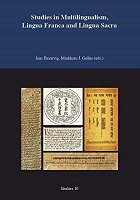Studies in Multilingualism, Lingua Franca and Lingua Sacra
| dc.contributor.editor | Braarvig, Jens | |
| dc.contributor.editor | Geller, Markham J. | |
| dc.date.accessioned | 2019-03-28 17:26:05 | |
| dc.date.accessioned | 2020-04-01T10:35:00Z | |
| dc.date.available | 2020-04-01T10:35:00Z | |
| dc.date.issued | 2018 | |
| dc.identifier | 1004755 | |
| dc.identifier | OCN: 1100536164 | en_US |
| dc.identifier.uri | http://library.oapen.org/handle/20.500.12657/25344 | |
| dc.description.abstract | The present book comprises a number of studies centered around the topic of how knowledge diffuses from one culture to another, and how knowledge diffusion is connected with the spread of languages and the conceptual systems they carry by translation. This diffusion also takes place also over linguistic borders, in the way that a given receiving language may also absorb systems of knowledge from languages that are linguistically quite unrelated but culturally connected with respect to knowledge transfer. Thus we find that Sumerian concepts with considerable impact were moved into the Akkadian language, along with writing-systems, religion, science and literature, even though linguistically the languages are completely unrelated. Another example is how Chinese culture and writing systems spread throughout East Asia into Korea, Japan and Vietnam, though the languages of these countries were linguistically unrelated to Chinese. The same case can be made for Buddhist ways of thinking when it was clothed in the garb of Chinese or Tibetan, or one of the other languages along the Silk Road. This is also true for the spread of Manicheism, as it was portrayed in a great number of languages, related or unrelated. German and Latin are linguistically related, but when Latin learning was communicated in Old High German, many of its terms were created in Middle German to accommodate the Latin conceptual world, and the German language was lastingly enriched with novisms denoting concepts of the Classical traditions of learning, in a process parallel to the spread of Greek Christianity into the East European cultures and languages. The book describes some cases of such knowledge transfer and what kind of mechanisms are involved in the ensuing language changes in the receiving languages and cultures. | |
| dc.language | English | |
| dc.relation.ispartofseries | Max Planck Research Library for the History and Development of Knowledge Studies | |
| dc.subject.classification | thema EDItEUR::C Language and Linguistics | en_US |
| dc.subject.classification | thema EDItEUR::C Language and Linguistics::CF Linguistics::CFD Psycholinguistics and cognitive linguistics::CFDM Bilingualism and multilingualism | en_US |
| dc.subject.other | Multilingualism | |
| dc.subject.other | culture | |
| dc.subject.other | languages | |
| dc.title | Studies in Multilingualism, Lingua Franca and Lingua Sacra | |
| dc.type | book | |
| oapen.relation.isPublishedBy | 13fd9223-a0df-4166-89b4-9bf5a0c67daf | |
| oapen.relation.isFundedBy | 7292b17b-f01a-4016-94d3-d7fb5ef9fb79 | |
| oapen.collection | European Research Council (ERC) | |
| oapen.series.number | 10 | |
| oapen.pages | 543 | |
| oapen.grant.number | 323596 | |
| oapen.grant.acronym | BabMed | |
| oapen.grant.program | FP7 SC39 | |
| oapen.remark.public | 21-7-2020 - No DOI registered in CrossRef for ISBN 9783945561133 | |
| oapen.identifier.ocn | 1100536164 |

